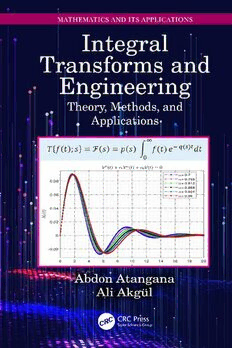Table Of ContentIntegral Transforms
and Engineering
With the aim to better understand nature, mathematical tools are being used
nowadays in many different fields. The concept of integral transforms, in par-
ticular, has been found to be a useful mathematical tool for solving a variety of
problems not only in mathematics but also in various other branches of science,
engineering, and technology.
Integral Transforms and Engineering: Theory, Methods, and Applications presents
a mathematical analysis of integral transforms and their applications. The book
illustrates the possibility of obtaining transfer functions using different integral
transforms, especially when mapping any function into the frequency domain.
Various differential operators, models, and applications are included such as
classical derivative, Caputo derivative, Caputo-Fabrizio derivative, and Atangana-
Baleanu derivative.
This book is a useful reference for practitioners, engineers, researchers, and
graduate students in mathematics, applied sciences, engineering, and technology
fields.
Integral Transforms
and Engineering
Theory, Methods, and
Applications
Abdon Atangana
Ali Akgül
First edition published 2023
by CRC Press
6000 Broken Sound Parkway NW, Suite 300, Boca Raton, FL 33487-2742
and by CRC Press
4 Park Square, Milton Park, Abingdon, Oxon, OX14 4RN
CRC Press is an imprint of Taylor & Francis Group, LLC
© 2023 Abdon Atangana, Ali Akgül
Reasonable efforts have been made to publish reliable data and information, but the author and
publisher cannot assume responsibility for the validity of all materials or the consequences of
their use. The authors and publishers have attempted to trace the copyright holders of all material
reproduced in this publication and apologize to copyright holders if permission to publish in this
form has not been obtained. If any copyright material has not been acknowledged, please write and
let us know so we may rectify in any future reprint.
Except as permitted under U.S. Copyright Law, no part of this book may be reprinted, reproduced,
transmitted, or utilized in any form by any electronic, mechanical, or other means, now known or
hereafter invented, including photocopying, microfilming, and recording, or in any information
storage or retrieval system, without written permission from the publishers.
For permission to photocopy or use material electronically from this work, access www.
copyright.com or contact the Copyright Clearance Center, Inc. (CCC), 222 Rosewood Drive,
Danvers, MA 01923, 978-750-8400. For works that are not available on CCC, please contact
[email protected]
Trademark notice: Product or corporate names may be trademarks or registered trademarks and are
used only for identification and explanation without intent to infringe.
ISBN: 978-1-032-41683-0 (hbk)
ISBN: 978-1-032-41820-9 (pbk)
ISBN: 978-1-003-35986-9 (ebk)
DOI: 10.1201/9781003359869
Typeset in Nimbus Roman
by KnowledgeWorks Global Ltd.
Dedication
Firstandforemost,wewouldliketopraiseandthankGod,the
Almighty,whohasgrantedcountlessblessings,knowledge,and
opportunitytothewriters,sothatwehavefinallybeenabletoreach
theaccomplishmentofcompletingourbook.
Wewishtoshowourgreatestappreciationtoourfamilies.Wecan’t
thankthemenoughfortheirtremendoussupportandhelp.Without
theirencouragementandguidance,thisbookwouldnothave
materialized.
Contents
Preface......................................................................................................................xv
Authors...................................................................................................................xvii
Chapter1 SumuduandLaplaceTransforms....................................................1
1.1 Definitions...............................................................................1
1.2 PropertiesofLaplaceandSumudutransforms.......................2
1.2.1 PropertiesofLaplace................................................3
1.2.2 PropertiesofSumudu...............................................3
1.2.3 SomeexamplesofSumuduandLaplace
transforms.................................................................4
Chapter2 TransferFunctionsandDiagrams..................................................13
Chapter3 AnalysisofFirst-orderCircuitModel1........................................17
3.1 Analysis of first-order circuit model 1 with classical
derivative...............................................................................17
3.2 Analysis of first-order circuit model 1 with Caputo
derivative...............................................................................19
3.3 Analysisoffirst-ordercircuitmodel1with
Caputo-Fabrizioderivative....................................................21
3.4 Analysisoffirst-ordercircuitmodel1with
Atangana-Baleanuderivative................................................23
Chapter4 AnalysisofFirst-orderCircuitModel2........................................27
4.1 Analysis of first-order circuit model 2 with classical
derivative...............................................................................27
4.2 Analysis of first-order circuit model 2 with Caputo
derivative...............................................................................30
4.3 Analysisoffirst-ordercircuitmodel2with
Caputo-Fabrizioderivative....................................................32
4.4 Analysisoffirst-ordercircuitmodel2with
Atangana-Baleanuderivative................................................34
vii
viii Contents
Chapter5 AnalysisofNoninvertingIntegratorsModel1..............................37
5.1 AnalysisofNoninvertingintegratorsmodel1with
classicalderivative................................................................37
5.2 AnalysisofNoninvertingintegratorsmodel1with
Caputoderivative..................................................................39
5.3 Analysis of Noninverting integrators model 1 with
Caputo-Fabrizioderivative....................................................40
5.4 Analysis of Noninverting integrators model 1 with
Atangana-Baleanuderivative................................................42
Chapter6 AnalysisofNoninvertingIntegratorsModel2..............................45
6.1 AnalysisofNoninvertingintegratorsmodel2with
classicalderivative................................................................45
6.2 AnalysisofNoninvertingintegratorsmodel2with
Caputoderivative..................................................................46
6.3 Analysis of Noninverting integrators model 2 with
Caputo-Fabrizioderivative....................................................48
6.4 Analysis of Noninverting integrators model 2 with
Atangana-Baleanuderivative................................................49
Chapter7 AnalysisofLagNetworkModel...................................................53
7.1 Analysisoflagnetworkmodelwithclassicalderivative......53
7.2 AnalysisoflagnetworkmodelwithCaputoderivative........56
7.3 Analysis of lag network model with Caputo-Fabrizio
derivative...............................................................................57
7.4 AnalysisoflagnetworkmodelwithAtangana-Baleanu
derivative...............................................................................59
Chapter8 AnalysisofLeadNetworkModel.................................................63
8.1 AnalysisofAnalysisofleadnetworkmodelwith
classicalderivative................................................................63
8.2 AnalysisofleadnetworkmodelwithCaputoderivative......65
8.3 Analysis of lead network model with Caputo-Fabrizio
derivative...............................................................................68
8.4 AnalysisofleadnetworkmodelwithAtangana-Baleanu
derivative...............................................................................69
Chapter9 AnalysisofFirst-orderCircuitModel3........................................73
9.1 Analysis of first-order circuit model 3 with classical
derivative...............................................................................73
9.2 Analysis of first-order circuit model 3 with Caputo
derivative...............................................................................75
Contents ix
9.3 Analysisoffirst-ordercircuitmodel3with
Caputo-Fabrizioderivative....................................................77
9.4 Analysisoffirst-ordercircuitmodel3with
Atangana-Baleanuderivative................................................79
Chapter10 AnalysisofFirst-orderCircuitModel4........................................83
10.1 Analysis of first-order circuit model 4 with classical
derivative...............................................................................83
10.2 Analysis of first-order circuit model 4 with Caputo
derivative...............................................................................85
10.3 Analysisoffirst-ordercircuitmodel4with
Caputo-Fabrizioderivative....................................................88
10.4 Analysisoffirst-ordercircuitmodel4with
Atangana-Baleanuderivative................................................89
Chapter11 AnalysisofFirst-orderCircuitModel5........................................93
11.1 Analysis of first-order circuit model 5 with classical
derivative...............................................................................93
11.2 Analysis of first-order circuit model 5 with Caputo
derivative...............................................................................95
11.3 Analysisoffirst-ordercircuitmodel5with
Caputo-Fabrizioderivative....................................................97
11.4 Analysisoffirst-ordercircuitmodel5with
Atangana-Baleanuderivative................................................99
Chapter12 AnalysisofaSeriesRLCCircuitModel.....................................103
12.1 Analysis of a series RLC Circuit model with classical
derivative............................................................................103
12.2 Analysis of a series RLC Circuit model with Caputo
derivative............................................................................106
12.3 AnalysisofaseriesRLCCircuitmodelwith
Caputo-Fabrizioderivative..................................................107
12.4 AnalysisofaseriesRLCCircuitmodelwith
Atangana-Baleanuderivative..............................................109
Chapter13 AnalysisofaParallelRLCCircuitModel..................................113
13.1 AnalysisofaparallelRLCcircuitmodelwithclassical
derivative.............................................................................113
13.2 Analysis of a parallel RLC circuit model with Caputo
derivative.............................................................................116
13.3 AnalysisofaparallelRLCcircuitmodelwith
Caputo-Fabrizioderivative..................................................117

